Travel Photography Tips: Taking Photos in Cities Worldwide
Article and photos by Volker Poelzl
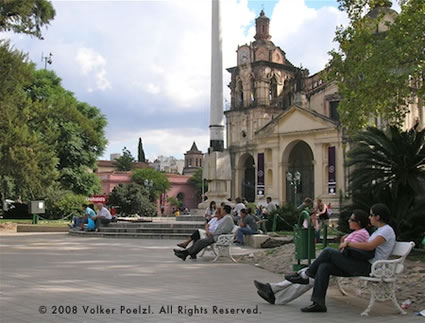
|
|
Including people in photographs of historic places helps to show the local atmosphere, as here in Cordoba, Argentina.
|
Cities are among the most challenging environments for travel photographers. Urban centers provide fascinating subject matter for pictures, but successfully creating a lively city portrait with your camera is no easy task. Many travelers just take photos of famous landmarks, their travel companions, or both of them together. It is a lot of fun to show pictures of you and your friends in front of the Eiffel Tower in Paris, but serious travel photography involves much more than just a collection of pleasant memories and photographic souvenirs.
When I take pictures in a city, my goal is to convey a sense of place and show the local atmosphere and way of life. To create a lively photo collection of your city vacation it is important to include a variety of different scenes and subject matter in addition to visual angles and perspectives. Travel is a journey of discovery while exploring a different country, culture, and people, and I consider travel photography to be part of that journey. The more curious and adventurous a traveler and photographer you are, the more you will want to get away from the main tourist sites and explore the local culture and way of life. By stepping off the beaten path you will make many interesting discoveries with your camera.
Observation Skills
To take great photographs you need to be attentive and pay attention to detail. Good observation skills are probably the most important asset of a photographer. Sure, it is great to take photos of famous landmarks such as the Spanish Steps in Rome, but what about including an old woman in your collecting as she sits by the fountain enjoying the afternoon sun? This adds local flavor to your pictures and tells the audience something about the people and not just famous tourist sites. Instead of taking a picture of a crowded shopping street in the city center, why not also take a picture of an old wrought-iron shop sign? A close-up view often tells the story better than showing the entire scene.
A sweeping view of Egypt’s pyramid is a compelling sight, but after you take that shot, why not experiment with a different angle and zoom setting? There is more to these massive structures than the “postcard” view recognized by everyone and photographed by everyone who has been there. Every landmark offers a myriad of different views and unusual angles that allow you to express a different aspect and quality of an already well-known monument.
France’s Gothic cathedrals are lofty and imposing monuments, but have you taken a look at the gargoyles and other pagan-inspired monsters that crowd the cathedrals’ upper structure? I have always found it fun to complement my photo collection with images of devils, monsters, and other freaky creatures of the medieval imagination that inhabit the less visible parts of Gothic facades. The beauty and mystery of a Gothic cathedral are often better expressed close-ups of the architectural details or sculptures than in a wide-angle shot that shows the entire church.
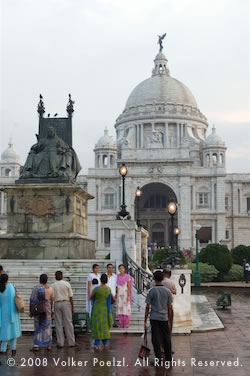
|
|
After a downpour Kolkata, India appears in a new light and with fresh colors.
|
Capture the Local Atmosphere
One of the challenges of city photography is to not just taking pictures of famous landmarks and sites, but portraying local atmospheres to create a sense of place. No modern city consists only of beautiful historic buildings, cathedrals, and castles. There are many modern buildings as well, urban congestion, traffic jams, as well as crowded sidewalks and squares. Amidst all the urban hustle and bustle there are many intimate subjects to photograph which reveal a slice of daily life in that city. Consider taking pictures of children playing in park, of animals, or pictures of the locals engaged in their daily activities, from sipping coffee at sidewalk cafés to shopping at markets. City life is so diverse that there are no limits to what you can include in your photographic journey of exploration. In India it was fun to take pictures of camels and elephants, which commonly share roads with cars, and of monkeys, which often roam freely in Indian cities.
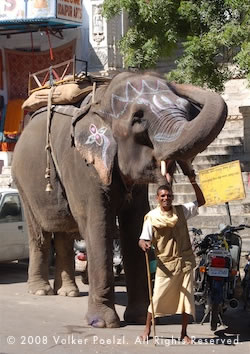
|
|
Working animals such as this elephant are great subject matter for city photography.
|
Go Off the Beaten Path and Explore Unusual Subject Matter
The most remarkable travel photographs are not those of famous sites we often see in travel brochures, but pictures taken by photographers who went off the beaten path to show a different aspect of a city or a different viewpoint or context. To go in search of new and interesting subject matter and escape from the often-intense urban atmosphere I often choose quiet neighborhoods, which allow for a more intimate at local life and interesting buildings. Such areas exist in most to provide relief from the noise, pollution, and crowds. There you will be able to explore different visual aspects of the city in your photography. Of my favorite things to photograph in any city are markets, fairs, cafés, as well as street performers in pedestrian zones near the city center, and locals in their daily activities. Architectural details such as windows, doorways, and sculptures, also provide visual interest. In Buenos Aires, after spending time in the city center, I often retreated to quiet neighborhoods to take in a different atmosphere. There I would photograph storefronts, windows and doorways, and focus on the small visual details that make Buenos Aires such an attractive city to explore.
Every city is a hodgepodge of the beautiful and the ugly, the quaint and the abject, the palatable and the repulsive. To create an authentic portrayal of a city I often take pictures of subject matter that is not necessarily beautiful but helps to create a realistic impression. Manaus, Brazil, the largest city in the Amazon, has many beautiful historic buildings from the era of the rubber boom in the late 19th century. But on my walks and explorations around the city I also discovered the less appealing aspects of this large urban center, such as the shantytowns that have sprung up along the city’s waterways, and the rusted carcasses of abandoned ships along the shores.
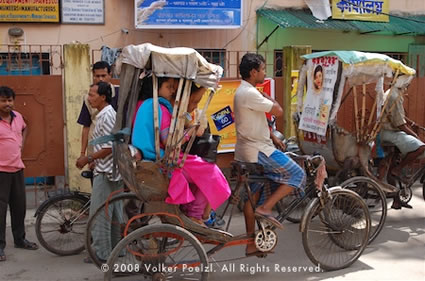
|
|
India's colorful cities offer great opportunities for photography.
|
Challenges of City Photography
It is easy to be overwhelmed by the wide boulevards, tall buildings, noisy traffic, and incessant stream of pedestrians that characterize most large cities. To find beautiful or interesting subject matter in an urban setting is quite a challenge and requires dedication and concentration. In addition, picturesque landmarks are often obstructed by power lines, passing traffic, and nearby modern buildings that affect the view. Sometimes even the most creative approaches and best lenses cannot compensate for some of the visual distractions we find in cities. When I took a picture of the Cathedral de Notre Dame in Paris from a bridge over the Seine, there was no way I could take a picture without including about ten tour buses that were prominently parked along the riverbank.
The weather and lighting conditions also have an impact on your photography. Shadows from neighboring buildings can ruin a shot, and aiming the camera in the direction of the sun often causes your subject matter to appear as a dark silhouette resulting in a reflection of sunlight in your photo. If you spend several days in one location you can observe the sunlight and shadows and then return at a time when you have the best view for your pictures. Morning and evening light is warmer than the light at midday, and you might want to consider what type of light works best with your chosen subject matter. Rain makes for bad photos, but colors are fresh and more saturated after a downpour, which makes it a great time to take pictures.
Safety can also be an issue in large cities, especially around tourist attractions that are often frequented by thieves and pickpockets. I usually carry my camera in a backpack and only take it out to take a picture. This is a little cumbersome, but at least I am not instantly recognized as a tourist and an easy target for camera theft. Small compact cameras can of course be easily carries in a jacket, and I have found small cameras often more practical on busy city streets than SLRs with large lenses that can easily attract unwanted attention.
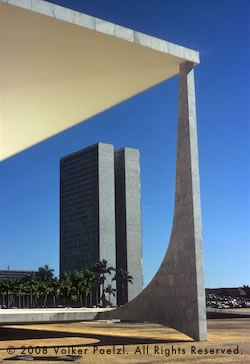
|
|
Few cities offer such wide spaces and clear architectural lines as Brazil's capital Brasilia.
|
The Digital Darkroom
For a dedicated amateur photographer, an image is not complete until some touch ups and adjustments on the computer. This allows you fine-tune exposure, saturation and brightness, and to sharpen parts of the image for a better visual effect. In the old days of film photographers had to make a choice between color and black and white film. With today’s digital cameras it is very easy to convert a color photo into a black and white image later on. Some photographs, especially of historic structures, often look better when converted to black and white. Most image-editing software allows for easy conversion of your color images, and you should not shy away from experimenting. Another important step in the digital darkroom is cropping. If you shot your photos in high resolution and large format, you should be able to crop and select parts of the image without losing picture quality. It is often after taking a photo that I discover an interesting angle or detail in one of my photos. By cropping or rotating a digital image you can create a totally new view of the subject matter — often with interesting and surprising results.
Volker Poelzl is a Living Abroad Contributing Editor for TransitionsAbroad.com. During his travels in over thirty countries worldwide he has visited hundreds of cities, always accompanied by his camera.
|
